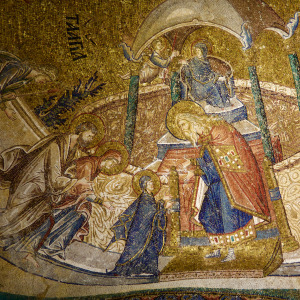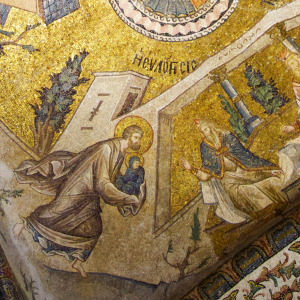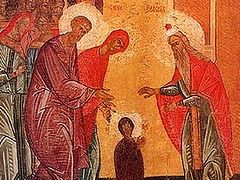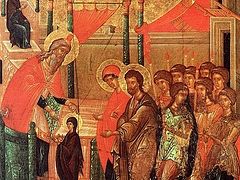Source: Synaxis
November 20, 2015
“Today the Theotokos, the temple that is to hold God, is led into the Temple and Zacharias receives her… Let us cry aloud with Gabriel: Rejoice, you who are full of grace, the Lord is with you, he who has great mercy.” So we sang at Vespers last night. The one who is to become the temple and palace of God is led into the temple.
 Presentation of the Theotokos in the Temple (Chora Church, 14th c, Istanbul)
Presentation of the Theotokos in the Temple (Chora Church, 14th c, Istanbul)
In the readings last night, we heard how, of old, the tabernacle was constructed according to the command of God as the place where the ark of testimony was to be placed, covered with a veil, illumined by candlesticks and lamps, with incense offered on a golden altar, and with the tabernacle and all the vessels anointed with the oil of anointing.
We heard that when it was finished, the tabernacle was overshadowed by the cloud and filled with the glory of the Lord, so that no one, not even Moses, was able to enter the tent.
Now, today, the Theotokos is led into the temple of the Lord, to preach Christ to all, and to become the temple, the dwelling place of the glory of God, overshadowed by the Holy Spirit; and not only the dwelling place, as the tabernacle of old, but the one who gives birth to God, so that in her and through her, in and through a human being, the glory of God radiates to the world.
All aspects of the temple point to her; she is their fulfillment. She is the jar containing the manna, the ark of the covenant, the rod of Aaron which budded forth, and all the other images we use to praise her. As we sang: “The written law has passed away and vanished as a shadow, and the rays of grace have shone forth at your entry into the temple of God, O undefiled Virgin Mother.” All the Law and the Prophets point to her; the reality has come and the shadows have passed away.
She is, as we sing, the fulfillment of the dispensation of the whole economy, indeed, of the whole of creation. As St Nicodemus put it: the world was created for Mary… and she for Christ. The whole world was created for the one who would say, “Let it be!”—the one who gives space to God as his temple and so allows the creator to enter his creation.
The tabernacle made by hands finds its fulfillment in the temple that is Mary, and through her, God enters this world to dwell amongst us, no longer hidden in the inner sanctuary in the man-made temple in Jerusalem, but dwelling among us, and now us in him.
She is the gate, as Ezekiel says, through which the Lord has entered the world: “O Gate of the Lord, unto you I open the gates of the temple,” Zacharias exclaims. “I now know and believe that the deliverance of Israel shall come to dwell openly in our midst.”
For this deliverance to come about, however, we must go one step further into the temple. The epistle reading spoke of how the priests would go into the outer tabernacle to perform their ritual services, but the high priest alone would go into the Holy of Holies only once a year, to offer blood for himself and the errors of the people.
The apostle continues: Christ himself, the High Priest of the good things to come, entered the greater and more perfect tabernacle, the one not made by human hands, entering once for all, offering not the blood of animal sacrifices, but his own blood, so securing an eternal redemption for all.
It is by his self-sacrifice that Christ enters this more perfect tabernacle and does so once-for-all… so that the gate remains shut: “It shall not be opened, and no man shall enter by it, for the Lord, the God of Israel, has entered by it. Therefore it shall remain shut,” says Ezekiel.
His sacrifice is once and for all—for all people and for all time. It is an eternal sacrifice and an eternal redemption. The gateway remains shut, but salvation is available for all.
 Blessing by the Priests (Chora Church, 14th c, Istanbul)
Blessing by the Priests (Chora Church, 14th c, Istanbul)
Today, then, as the Theotokos enters the temple, preaching Christ to all, she becomes the one through whom the glory of God enters this world, by being the gateway through which the Lord enters the more perfect tabernacle, offering his eternal sacrifice and being the High Priest of the good things to come. She is the bridge, the passageway or the exodus from creation to recreation and redemption.
The Temple is both the place where God enters the world and the place where the sacrifice is made; and these two aspects—the womb and the tomb—cannot be separated.
For all this to happen, of course, Mary had to say: “Let it be!” Not only “Let the power of the most high overshadow me,” but also, “Let the sword piece my heart, too.”
Yet these words of Mary—“Let it be!”—are glaringly absent from the hymnography for this feast. The reason for this is because, today, as we celebrate this feast, she is our “Let it be!” She is the completion or culmination of creation as it—as we—respond to the Word of God.
Mary is not simply brought into the temple; she is offered there, she is sacrificed by our “Let it be!” Joachim and Anna, the hymns said, “rejoice exceedingly, for they have offered to God, as a three-year old victim of sacrifice, the Queen without blemish.” Mary is the pure and blameless sacrifice to God on behalf of all human beings, “the dove without blemish and the ewe-lamb of God without spot.” This is what it means to say “Let it be”!
For our high calling, to be conformed to the image and likeness of God, for this to be realized, we too need to be able to say for ourselves: Let it be!
God does not enter into this world except by our offering him space, not a geographical space somewhere else in the world, but our own place—ourselves and our own time, today—the sacrifice of our own sense of self, our attempts to construct our own identity, to set limits and boundaries on how much we are prepared to accept, to say “let it be,” but only on my terms.
No! Our own terms need to be sacrificed if we are to say: Let it be! We must sacrifice ourselves, becoming ourselves temples of God, sacrificing ourselves on the altar of our heart, so that he can now be present in us and through us; we must decrease so that he might increase.
This has been accomplished in our offering of the virgin child Mary. In a month’s time we will sing of how we offer her at Christ’s Nativity and for his Nativity; today we offer her as the temple and the Gate of the Lord, so that High Priest can, by his own once-for-all sacrifice enter the Holy of Holies. We too, even we, can be refashioned—pass through from the creation to the new creation, but only if we can say for ourselves, “Let it be!”
As we present the Theotokos into the temple today, saying to God “Let it be,” let us not misunderstand what it demands of us as ourselves temples of God. May we have the strength to say with her: “Let it be!”




